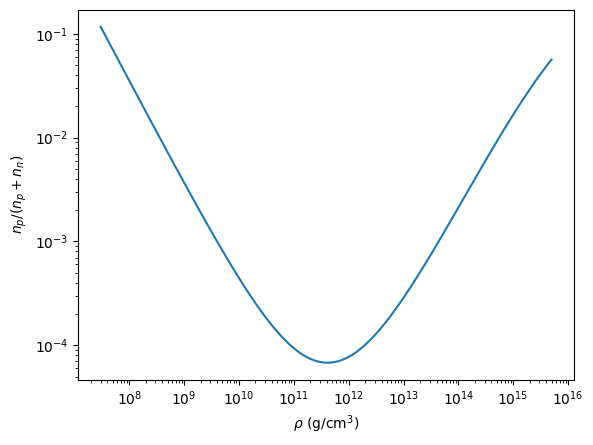Homework 8 solutions#
1. Neutron star composition#
We want to look at chemical equilibrium for a neutron star to determine the relative fraction of neutrons, protons, and electrons.
Our balance equation is:
where \(Q = 0.782~\mathrm{MeV}\).
a.#
Chemical equilibrium says that:
since we are degenerate, we can relate the chemical potential to the Fermi energy:
and then we have
or rearranging:
where we recognize the term \([\ldots]\) as \(Q\).
This gives
b.#
Now we take the electrons to be relativistic, zero-temperature degenerate:
with
and we take \(n\) and \(p\) to be non-relativistic, zero-temperature degenerate:
with
Putting this together, we have:
Now, we can take \(m_p \approx m_n \approx m_u\) in the above expression (since we are not subtracting the masses) and we can express the mass density as:
since \(m_e \ll m_p\)
The we have:
and charge neutrality requires that \(n_e = n_p\), giving
We can solve this system numerically
c.#
Here’s our code to generate a numerical solution
import numpy as np
import scipy.optimize as optimize
import matplotlib.pylab as plt
# constants (CGS)
c = 3.e10
h = 6.63e-27
m_u = 1.67e-24
m_e = 9.11e-28
MeV_to_erg = 1.602e-12 * 1.e6
Q = 0.782 * MeV_to_erg
def saha(n_n, rho):
n_p = rho/m_u - n_n
a = (3.0/(8.0*np.pi))**(1./3.)
# neutron
x_n = a* (h/(m_u*c)) * n_n**(1./3.)
p_n = m_u * c * x_n
E_n = 0.5 * p_n**2 / m_u
#E_n = m_u*c**2*( (1.0 + x_n**2)**0.5 - 1)
# proton
x_p = a * (h/(m_u*c)) * n_p**(1./3.)
p_p = m_u * c * x_p
E_p = 0.5 *p_p**2 / m_u
#E_p = m_u*c**2*( (1.0 + x_p**2)**0.5 - 1)
# electron
x_e = a * (h/(m_e*c)) * n_p**(1./3.)
p_e = m_e * c * x_e
E_e = p_e * c
#E_e = m_e*c**2*( (1.0 + x_e**2)**0.5 - 1)
f = E_n + Q - E_p - E_e
return f
rho_v = []
np_nn = []
for rho in np.logspace(np.log10(3.e7), np.log10(5.e15), 100):
n_n_max = rho / m_u
n_n = optimize.brentq(saha, 0.0001*n_n_max, n_n_max, args=(rho))
n_p = rho/m_u - n_n
rho_v.append(rho)
np_nn.append(n_p/(n_p + n_n))
fig, ax = plt.subplots()
ax.loglog(rho_v, np_nn)
ax.set_xlabel(r"$\rho~ (\mathrm{g}/\mathrm{cm}^{3})$")
ax.set_ylabel(r"$n_p / (n_p + n_n)$")
Text(0, 0.5, '$n_p / (n_p + n_n)$')

We see that the number of protons is always small compared to the number of neutrons
2. X-ray bursts#
We want to understand the depth at which H burns in an X-ray burst
a.#
We define column depth as:
starting with HSE:
we can write this as:
this can be integrated trivally together with the boundary condition that \(P(y = 0) = 0\) to give:
b.#
The change in H mass fraction is given by:
where \(\epsilon_H\) is a constant (it is the hot-CNO rate, which we say in a previous homework is temperature independent).
Taking
and
we have:
but we want all of the H to be consumed, which means \(X(t) = 0\). This gives:
For a typical \(Z_\mathrm{CNO} \approx 0.01\), this is:
c.#
The column accretion rate is
so we can write:
We can integrate this as:
where \(X(y = 0) = X_0\), the surface / accreted amount of H.
d.#
The critical column depth where all of the H is burned is \(X(y_\mathrm{crit}) = 0\), giving:
and we can write this as:
Now we want to evaluate this. Start with the Eddington accretion rate:
with \(\sigma_T = 6.65\times 10^{-25}~\mathrm{cm^2}\). This gives:
and

